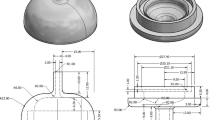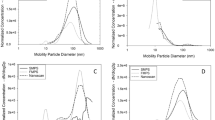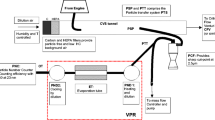Abstract
The accurate measurement of airborne particles in the nanometer range is a challenging task. Because several studies have linked exposures to airborne ultrafine particles to elevated human health risks, the need to assess the concentrations of particles in the workplace that are below 100 nm in diameter is imperative. Several different techniques for monitoring nanoparticles are now available, and others are currently being tested for their merit. Laboratory condensation particle counters (CPC), field-portable CPC, nanometer differential mobility analyzers, electron microscopy, and other novel and experimental approaches to measuring nanoparticles have been recently used in investigations. The first part of this article gives an overview of these techniques, and provides the advantages and disadvantages for each. The second part of this article introduces a portable technique, coupling two particle measurement devices that are capable of characterizing microscale and nanoscale particles in the field environment. Specifically, this pilot study involved the use of a direct-reading CPC and a laser particle counter to measure airborne concentrations of ultrafine particles during a laboratory machining process. The measurements were evaluated in real time, and subsequently, decisions regarding human exposure could be made in an efficient and effective manner. Along with the results from this study, further research efforts in related areas are discussed.
Similar content being viewed by others
References
K. Geiser, Nanotechnology and Environmental and Public Health Considerations, N. Solut., 2004, 14(1), p 9–18
G. Bozorius, K. Hameri, J. Pekkanen, and M. Kulmala, Spatial Variation of Aerosol Number Concentration in Helsinki City, Atmos. Environ., 1999, 33(4), p 553–565
D. Dockery and C. Pope, Acute Respirator Effects of Particulate Air Pollution, Annu. Rev. Public Health, 1994, 15(1), p 107–132
M. Jamriska, L. Morawska, and D.S. Eusor, Control Strategies for Sub-Micrometer Particles Indoors: Model Study of Air Filtration and Ventilation, Indoor Air, 2003, 13(1), p 96–105
J.A. Sarnat, P. Demokritou, and P. Koutrakis, Measurement of Fine, Coarse and Ultrafine Particles, Annual 1st Super Sanita, 2003, 39(3), p 351–355
National Institute of Occupational Safety and Health (NIOSH), NIOSH Safety and Health Topic: Nanotechnology, Available at: http://www.cdc.gov/niosh/topics/nanotech/. Accessed February 7, 2005
Institute of Occupational Medicine for Health & Safety, Executive 2004 Research Report 274, Available at: http://www.hse.gov.uk/research/rrpdf/rr274.pdf
A. Peters, H.E. Wichmann, T. Tuch, J. Heinrich, and J. Heyder, Respiratory Effects are Associated with the Number of Ultrafine Particles, Am. J. Respir. Crit. Care Med., 1997, 155(4), p 1376–1383
ARTI Instruments Inc, Available at: http://www.artinstruments.com
Dekati Ltd, Available at: http://www.dekati.com
H.W. Gaggeler, V. Baltensperger, M. Emmenegger, D.T. Jost, A. Schmidt-Ott, P. Haller, and M. Hoffmann, The Epiphaniometer, a New Device for Continuous Aerosol Monitoring, J. Aerosol Sci., 1989, 20(6), p 557–564
D.B. Kittleson, Engines and Nanoparticles: A Review, J. Aerosol Sci., 1998, 29(6), p 575–588
TSI Inc, Innovative Measurement Solutions, Available at: http://www.tsi.com
A.D. Maynard, Y. Ito, I. Arslan, A.T. Zimmer, N. Browning, and A. Nicholls, Examining Elemental Surface Enrichment in Ultrafine Aerosol Particles Using Analytical Scanning Transmission Electron Microscopy, Aerosol Sci. Technol., 2004, 38(4), p 365–381
Washington University-St. Louis, Dr. Da Ren Chen’s faculty webpage, Available at: ttp://mesun4.wnstl.edu/me/faculty/dc/dc_research.pdf
Author information
Authors and Affiliations
Rights and permissions
About this article
Cite this article
Handy, R.G., Jackson, M.J., Robinson, G.M. et al. The measurement of ultrafine particles: A pilot study using a portable particle counting technique to measure generated particles during a micromachining process. J. of Materi Eng and Perform 15, 172–177 (2006). https://doi.org/10.1361/105994906X95823
Received:
Revised:
Issue Date:
DOI: https://doi.org/10.1361/105994906X95823




